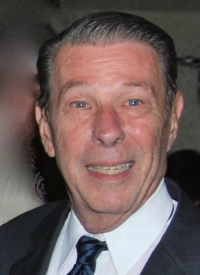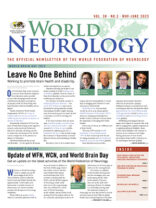By Vladimir Hachinski, CM, MD, DSc, FRCPC, FCAHS, FRSC

Dr. James F. Toole at the World Congress of Neurology in Marrakesh 2011, aged 86.
We met by mail. He asked me to contribute a chapter on the cerebral circulation to his multi-edition cerebrovascular diseases book. I felt honored. We became friends, and much later, I was the coordinator of Canadian Centers for his landmark Asymptomatic Carotid Stenosis Study (ACAS).
Along the way, I knew him as president of the American Neurological Association, the International Stroke Society, and the World Federation of Neurology (WFN).
Jim was born in Philadelphia, and educated at Princeton and Cornell Medical College. In addition, he earned a union card as a carpenter at age 12, and a Master of Laws from LaSalle University, while serving as a flight surgeon on an aircraft carrier in the Pacific.
In 1951, he saw combat in Korea, meriting a bronze star with a V for Valor. Although he had many job choices, he made his career in Bowman Gray School of Medicine, where he became the Walter C. Teagle professor of neurology. His department became a stroke and international center attracting trainees from several continents. He pioneered team research, ultrasonography, and clinical trials in stroke. As president of the International Stroke Society, he presided over the landmark Stroke World Congress in Vancouver in 2004.
Jim had early involvement with the WFN. He was secretary-treasurer, editor of the Journal of Neurological Sciences, and then president (1997-2001). He convened a retreat and from it arose a Strategic Planning Group that recommends major changes to the mission, organization, and strategic goals, that have guided his successors as presidents.
After presiding over the highly successful World Congress of Neurology in 2001 in London, UK, he wrote his last President’s Column. As always, with an eye on the future, he wrote that in a globalizing world, the WFN should be, “A neutral forum for the discussion of global, regional, and approaches to neurologic illnesses” and to become “a voice in global policymaking.”
I had the privilege of serving with him as chair of the Steering Committee of the WFN. At the end, he gave me a generous worded diploma, and said I was “the compass,” because I kept things on an even keel. He also issued diplomas to patients participating in his studies since he believed that they play a crucial role, as they certainly do.
He was always well dressed, well groomed, and looking younger than his age. (see photo). He was courteous and calm. Stroke was a new field with few certainties. Where knowledge fails, controversies thrive, so as a pioneer he could not avoid being part of many. However, he always took the high road, earning the sobriquet of “Gentleman Jim.”
In addition to his family, his wife Lady Pat, his four children, 10 grandchildren, and four great grandchildren, he leaves many pupils. Mentioning a few risks offending the many, but they know who they are and pay daily tribute to his memory by continuing his work. They are leaders in fields where there had been no paths, and Jim left them trails. •
Vladimir Hachinski, CM, MD, DSc, FRCPC, FCAHS, FRSC, Dr hon. Causa is Distinguished University Professor at the University of Western Ontario, and a past-president of the WFN.
